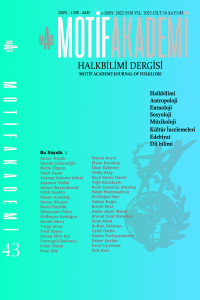ANADOLU SAHASI TÜRK HALK ŞİİRİNDE TURNA: DERDİÇOK ÖRNEĞİ
CRANE IN ANATOLIAN FIELD TURKISH FOLK POETRY: DERDIÇOK EXAMPLE
Author(s): Bedri ÖzçelikSubject(s): Cultural history, Customs / Folklore, Social history, Turkish Literature, Culture and social structure , Sociology of Literature
Published by: Motif Halk Oyunları Eğitim ve Öğretim Vakfı
Keywords: Crane; Turkish folk poetry; Afşin-Elbistan Cultural Basin; Derdiçok;
Summary/Abstract: The Anatolian field of Turkish folk poetry, which was founded by the nomadicmarried Turks living in Central Asia by hunting and husbandry, and accepted as one of the cultural heritages of Turkish wisdom, is one of the literary assets that carry the material and spiritual values of the culture that survives in this geography from generation to generation and reflects the sense of beauty of the people. The nature which appears in the center of human life has influenced the formation and configuration of Turkish Folk Poetry tradition. The animals which are one of the main and natural elements of nature have been accepted as one of the most distinctive cultural dynamics of mankind since ancient times. The crane, which takes part in the animal world, is one of the bird species, and accepted as a connotation symbol in many fields of Turkish literature, has also been handled and processed as a common motif in Anatolian Turkish folk poetry. The use of crane motif as an image in Turkish folk poetry, which reflects the feelings, thoughts, and tastes of the Anatolian people and Derdiçok’s poems with crane motifs constitute the subject of this study. The aim of the study is determining the characteristics of the crane in the poems of Derdiçok, who is accepted as one of the well-known representatives of the Turkish folk poetry tradition of minstrel style and in Turkish folk poetry that emerged, developed and matured in this geography, and contributing to the field by interpreting these texts. In this study, it has been determined that the crane is discussed with its beauty, its resemblance to a lover, and the qualification of bringing news in various verse forms and types of Turkish folk poetry tradition. In addition to this, information about the life of Derdiçok, who lived in the AfşinElbistan Cultural Basin in the last quarter of the nineteenth century and the first quarter of the twentieth century, was given, and the content analysis of his poems with crane motif was made. After all, it has been seen that the crane takes place in Derdiçok's poems, with its features in Anatolian field Turkish folk poetry; at the same time the poet's didactic poems in which he gave advice to the cranes in order to be vigilant against their enemies, as well as his conversational poems in which he communicated with them were determined, and all his poems with crane motifs were analysed.
Journal: Motif Akademi Halkbilimi Dergisi
- Issue Year: 16/2023
- Issue No: 43
- Page Range: 1077-1099
- Page Count: 23
- Language: Turkish

